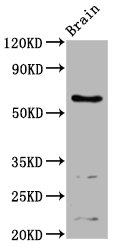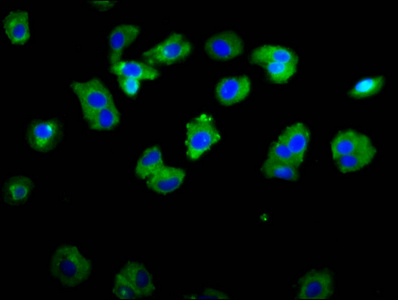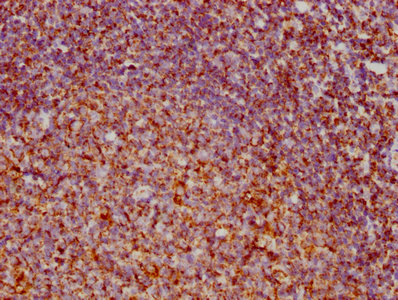ASIC1 Antibody
-
货号:CSB-PA001142LA01HU
-
规格:¥440
-
促销:
-
图片:
-
Western Blot
Positive WB detected in: Mouse brain tissue
All lanes: ASIC1 antibody at 4.24μg/ml
Secondary
Goat polyclonal to rabbit IgG at 1/50000 dilution
Predicted band size: 60, 65, 63 kDa
Observed band size: 60 kDa -
Immunofluorescence staining of HepG2 cells with CSB-PA001142LA01HU at 1:133, counter-stained with DAPI. The cells were fixed in 4% formaldehyde, permeabilized using 0.2% Triton X-100 and blocked in 10% normal Goat Serum. The cells were then incubated with the antibody overnight at 4°C. The secondary antibody was Alexa Fluor 488-congugated AffiniPure Goat Anti-Rabbit IgG(H+L).
-
-
其他:
产品详情
-
产品名称:Rabbit anti-Homo sapiens (Human) ASIC1 Polyclonal antibody
-
Uniprot No.:P78348
-
基因名:ASIC1
-
别名:ACCN2 antibody; ACCN2_HUMAN antibody; Acid sensing ion channel 1 antibody; Acid sensing ion channel 1a protein antibody; Acid sensing ion channel antibody; Acid-sensing ion channel 1 antibody; AI843610 antibody; Amiloride sensitive cation channel 2 neuronal antibody; Amiloride-sensitive cation channel 2 antibody; ASIC antibody; ASIC1 antibody; ASIC1A antibody; B530003N02Rik antibody; BNaC2 antibody; Brain sodium channel 2 antibody; Cation channel amiloride sensitive neuronal 2 antibody; hBNaC2 antibody; neuronal antibody
-
宿主:Rabbit
-
反应种属:Human, Mouse
-
免疫原:Recombinant Human Acid-sensing ion channel 1 protein (195-297AA)
-
免疫原种属:Homo sapiens (Human)
-
标记方式:Non-conjugated
本页面中的产品,ASIC1 Antibody (CSB-PA001142LA01HU),的标记方式是Non-conjugated。对于ASIC1 Antibody,我们还提供其他标记。见下表:
-
克隆类型:Polyclonal
-
抗体亚型:IgG
-
纯化方式:>95%, Protein G purified
-
浓度:It differs from different batches. Please contact us to confirm it.
-
保存缓冲液:Preservative: 0.03% Proclin 300
Constituents: 50% Glycerol, 0.01M PBS, pH 7.4 -
产品提供形式:Liquid
-
应用范围:ELISA, WB, IF
-
推荐稀释比:
Application Recommended Dilution WB 1:500-1:5000 IF 1:50-1:200 -
Protocols:
-
储存条件:Upon receipt, store at -20°C or -80°C. Avoid repeated freeze.
-
货期:Basically, we can dispatch the products out in 1-3 working days after receiving your orders. Delivery time maybe differs from different purchasing way or location, please kindly consult your local distributors for specific delivery time.
相关产品
靶点详情
-
功能:Isoform 2 and isoform 3 function as proton-gated sodium channels; they are activated by a drop of the extracellular pH and then become rapidly desensitized. The channel generates a biphasic current with a fast inactivating and a slow sustained phase. Has high selectivity for sodium ions and can also transport lithium ions with high efficiency. Isoform 2 can also transport potassium, but with lower efficiency. It is nearly impermeable to the larger rubidium and cesium ions. Isoform 3 can also transport calcium ions. Mediates glutamate-independent Ca(2+) entry into neurons upon acidosis. This Ca(2+) overloading is toxic for cortical neurons and may be in part responsible for ischemic brain injury. Heteromeric channel assembly seems to modulate channel properties. Functions as a postsynaptic proton receptor that influences intracellular Ca(2+) concentration and calmodulin-dependent protein kinase II phosphorylation and thereby the density of dendritic spines. Modulates activity in the circuits underlying innate fear.; Isoform 1 does not display proton-gated cation channel activity.
-
基因功能参考文献:
- Data show that acid-sensing ion channel 1a (ASIC1a) expression level was significantly higher in gastric carcinoma (GC) tissues. PMID: 29584803
- Study shows that bile acids potentiate proton-activated currents in Xenopus laevis oocytes expressing human acid-sensing ion channel. Site-directed mutagenesis demonstrated that the amino acid residue G433 is critically involved in the potentiating effect of bile acids on ASIC1a activation by protons. PMID: 28193786
- Genetic variants in the ACCN2 are associated with differential sensitivity to CO2. PMID: 28121219
- The deactivation of ASIC1 was steeply dependent on the pH, spanning nearly three orders of magnitude from extremely fast at pH 8 to very slow at pH 7. PMID: 28265090
- Results show that the "acidic pocket," the binding site of several toxins, is not essential for channel function but has, rather, a modulatory role. Furthermore, the study describes the structural rearrangements occurring in this domain during ASIC activity, and highlight the importance of the "palm" domain in channel opening and current decay. PMID: 28320963
- our results suggest that ASIC1a is critical for liver cancer cell proliferation and its deregulation is frequently linked to liver cancer PMID: 27462920
- the data demonstrate a functional link between ASICs and [Ca(2+)]i/RhoA pathway, which contributes to the acidity-induced epithelial-mesenchymal transition. PMID: 28518134
- ASIC1 contributes to breast cancer pathogenesis in response to acidic tumor microenvironments PMID: 26686084
- Data show that acid sensing ion channel 1a (ASIC1a) mediated calcium influx, which resulted in the activation of PI3K/AKT signaling and increased drug resistance, suggesting that ASIC1a/Ca(2+)/PI3K/AKT signaling represents a pathway that regulates drug resistance, thus offering a potential target for chemotherapy of hepatocellular carcinoma (HCC). PMID: 27918554
- Downregulation of ASIC1 inhibits gastric cancer growth via decreasing autophagy, therefore this strongly suggests a therapeutic role for ASIC1 in gastric cancer. PMID: 28111260
- The C mutated allele for ACCN2 rs685012 polymorphism was more frequent in panic disorder patients. The ACCN2 TT/ADORA2A CT diplotype were more represented in controls. This suggests a role for ACCN2 rs685012 polymorphism in PD development in Caucasian PMID: 26589317
- analysis of a major ASIC1a homotetramer at the surface membrane of the cell expressing functional ASIC1a channel PMID: 26252376
- Our findings support previously reported associations between ASIC1 and panic/anxiety, but not other genes previously associated with anxiety disorders. The PMID: 25913301
- Putative GABAA and ASIC1a channels functionally interact with each other, possibly via an inter-molecular association by forming a novel protein complex. PMID: 24923912
- A novel interaction between ASIC1 and integrin-Beta1, mediated by alpha-actinin was determined in glioma tumor cells. PMID: 26108662
- Suppression of ASIC1alpha expression by RNAi attenuated the malignant phenotype of hepatocellular carcinoma cells, suggesting a novel approach for anticancer gene therapy. PMID: 25613068
- ASIC1a opening is accompanied by a distance increase between adjacent thumb and palm domains as well as a movement of Glu-235 relative to the knuckle helix. PMID: 26070563
- ASIC1A and ENaCalpha form functional heterotrimers acting as ion channels. PMID: 26032502
- This study suggests that ASIC1 may play a role as mediators of inflammatory pain and be involved in the pathogenesis of frozen shoulder. PMID: 26033064
- Genetic variation at ACCN2 appears to be associated with panic disorder and with amygdala phenotypes that have been linked to proneness to anxiety. PMID: 24529281
- Down-regulated expression of ASIC1 RNA and protein was detected in the dysplastic cortex of focal cortical dysplasia patients. PMID: 24682892
- Provide evidence for the roles of OGR1 and ASIC1a in the regulation of intestinal passive Mg(2+) absorption. PMID: 24375028
- results suggest that FPI induces cerebral acidosis that activates ASIC channels and contributes to secondary injury in TBI. They also suggest a therapeutic strategy to attenuate the adverse consequences of TBI PMID: 23991103
- it can be concluded that CaMKII regulates the activity of ASIC1, which is associated with the ability of GBM cells to migrate. PMID: 24100685
- Regions of the extracellular palm domain and the beta(11-12) linker are important for inactivation and steady-state desensitization of ASIC1a. PMID: 23977127
- ASIC1a channels desensitize rapidly in the presence of a continuous acidosis or following a preexposure to minor pH drop, raising doubt for their contributions to the acidosis-mediated neuronal injury. PMID: 23224900
- ASIC1a has two desensitized states with markedly different stabilities. PMID: 23048040
- The results of this study demonstrated for the first time an association between an ASC1a variant allele and TLE in a Han Chinese population. PMID: 21664108
- These data suggest that different ENaC/ASIC1 subunits interact and could combine to form a hybrid channel that likely underlies the amiloride-sensitive current seen in human glioma cells. PMID: 21346156
- Results indicate that PICK1 regulates trafficking and function of ASIC1a in a lipid binding-dependent manner. PMID: 21176140
- analysis of the ASIC1a and ASIC1b calcium permeable human acid-sensing ion channel 1 transcript variants PMID: 21036899
- analysis of a complex between the sigma-1 receptor and a target ion channel, analysis of the stoichiometry of the interaction as 1 sigma-1 receptor/1 ASIC1a subunit PMID: 20371317
- matriptase is expressed in glioma cells and that matriptase specifically cleaves ASIC1 in heterologous expression systems. PMID: 20601429
- functional homomeric ASIC1a channels are predominantly expressed in neurons from the human brain. PMID: 20216553
- A combined computational and functional approach identifies new residues involved in pH-dependent gating of ASIC1a. PMID: 20299463
- The contact region between three domains of the extracellular loop of ASIC1a is critical for channel function. PMID: 20215117
- analysis of amiloride docking to acid-sensing ion channel-1 PMID: 20048170
- wild type CFTR elevates the acid-gated Na(+) current of ASIC1a/2a in part by altering the kinetics of extracellular Na(+) interaction. PMID: 11748227
- participation of multiple PKC isotypes contributes to the overall activity of BNaC2 PMID: 12244121
- ASICs are leading acid sensors in human nociceptors and VR1 participates in the nociception mainly under extremely acidic conditions. PMID: 12393854
- ASIC1a and H(+)-gated currents may contribute to the development of abnormal fear and to anxiety disorders. PMID: 14988500
- Ibuprofen studies show ASIC1a is a significant contributor to cutaneous acid-induced pain. PMID: 15574747
- These observations strongly suggest the acid-induced current is mediated by ASIC1 channels. PMID: 15576453
- expression of vanilloid receptor subtype-1 and acid-sensing ion channel genes in the human trigeminal ganglion neurons PMID: 15738111
- Data found ACCN2 interact with ataxin-3 and provide new clues for the pathogenesis of spinocerebellar ataxia type 3 and Machado-Joseph disease (SCA3/MJD). PMID: 15952105
- functional expression of ASICs is characteristic feature of adenoid cystic carcinomas cells PMID: 17324378
- Sulfhydryl compounds potentiate H(+)-gated currents via two mechanisms, metal chelation and redox modulation of target amino acids. PMID: 17392378
- Spontaneous currents represent activation of acid-sensitive ion channels (ASICs) by autocrine vesicular release of protons from HEK cells. PMID: 17443677
- endogenous peptides shift steady-state desensitization suggests that RF-amides could impact the role of ASIC1a in both pain and neuronal damage following stroke and ischemia. PMID: 17984098
- A case-control twin study could not detect association of ACCN2 with genetic risk shared among human anxiety spectrum disorders. PMID: 18349698
显示更多
收起更多
-
亚细胞定位:Cell membrane; Multi-pass membrane protein.
-
蛋白家族:Amiloride-sensitive sodium channel (TC 1.A.6) family, ASIC1 subfamily
-
组织特异性:Expressed in most or all neurons.
-
数据库链接:
HGNC: 100
OMIM: 602866
KEGG: hsa:41
UniGene: Hs.274361
Most popular with customers
-
YWHAB Recombinant Monoclonal Antibody
Applications: ELISA, WB, IF, FC
Species Reactivity: Human, Mouse, Rat
-
-
-
-
-
-
-
VDAC1 Recombinant Monoclonal Antibody
Applications: ELISA, WB, IHC
Species Reactivity: Human, Mouse, Rat























